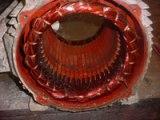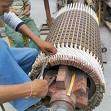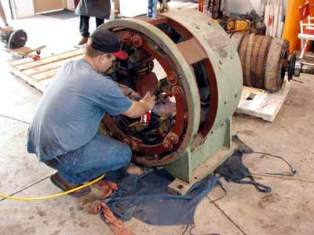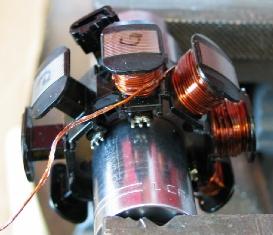Winding wire for rewinding and repairing electric motors
Winding wires for rewinding and repairing electric motors are made of round and rectangular cross-sections and, depending on the material of the wire (current-carrying wire), the type and method of laying insulation, are divided into classes.
The most common are conductors with a coil of copper wire.
Insulating materials for winding wires
Winding wires are made with fiber, enamel and composite insulation.
Materials for fiber insulation of motor rewind windings are: paper (cable or telephone), cotton yarn; natural and artificial silk - nylon, lavsan; asbestos and glass fibers.
These materials can be applied in one, two or more layers, in the form of a coil and in the form of a braid (sock).
 The main materials for enamel insulation are: enamel based on polyvinyl acetal (vinylflex), enamel on polyamide resol varnish, enamel on metalvin varnish, polyurethane enamel, enamel on the basis of terephthalic acid polyesters, silicon-silicon enamel.
The main materials for enamel insulation are: enamel based on polyvinyl acetal (vinylflex), enamel on polyamide resol varnish, enamel on metalvin varnish, polyurethane enamel, enamel on the basis of terephthalic acid polyesters, silicon-silicon enamel.
Winding wire brands have conventional letter designations. Some brands, after the letter designation, also have the number 1 or 2. The number 1 indicates the normal thickness of the winding wire insulation, and the number 2 indicates the reinforced thickness.
Brands of winding wires
Designation of brands of winding wires begins with the letter P (wire). Fiber insulation has the designations: B — cotton yarn, W — natural silk, ShK or K — artificial silk — nylon, C — fiberglass, A — asbestos fiber, O or D — respectively indicate one or two layers of insulation on the winding wire. For example, the brand PBD stands for: winding wire, copper, insulated with two layers of cotton yarn.
The enamel insulation of the coiled wires has the following designations: EL — varnish-resistant enamel, EV — high-strength enamel (vinylflex), ET — heat-resistant polyester enamel, EVTL — polyurethane enamel, ELR — polyamide resin enamel.
 For example, the brand PEL stands for: copper winding wire coated with lacquer-resistant enamel, PEV -1 — copper winding wire insulated with one layer of Viniflex enamel, PETV — copper winding wire insulated with enamel based on terephthalic acid polyesters, PETK — copper winding wire insulated with silicon-silicon enamel, PB — copper winding wire insulated with several layers of cable paper, PBO — copper winding wire insulated with one layer of cotton yarn.
For example, the brand PEL stands for: copper winding wire coated with lacquer-resistant enamel, PEV -1 — copper winding wire insulated with one layer of Viniflex enamel, PETV — copper winding wire insulated with enamel based on terephthalic acid polyesters, PETK — copper winding wire insulated with silicon-silicon enamel, PB — copper winding wire insulated with several layers of cable paper, PBO — copper winding wire insulated with one layer of cotton yarn.
Composite insulation consists of enamel insulation over which fiber insulation is laid. For example, the brand PELBO stands for: copper wire coil coated with lacquer-resistant enamel and then cotton yarn in one layer, PELSHO-copper winding wire insulated with lacquer-resistant enamel and one layer of natural silk.
The degrees of coiled wires insulated with fiberglass and impregnated with heat-resistant varnish have the letter K. For example, wire from the PSDK brand.
How to choose a winding wire for repairing and rewinding an electric motor
The choice of the brand of wire used in the repair of windings of electric motors is determined by the required class of heat resistance, the permissible thickness of the insulation (determined by the filling factor of the basin or the available dimensions for placing the windings) and the requirements in terms of moisture resistance, frost resistance, chemical resistance and mechanical strength of the insulation.

Coiled wires with enamel insulation have the smallest insulation thickness. Their use is recommended when the channel fill factor is high. The smooth surface of the wires ensures ease of laying them in the grooves, and the small thickness of the insulation with the relatively high thermal conductivity — low overheating of the winding.
The use of enamel-insulated wires must necessarily be related to the types of varnishes and thinners that are used in this establishment or that it can provide. Some varnishes and thinners have a destructive effect on the enamel insulation of the wires. In addition, at a temperature of 160 — 170 ° C, this insulation becomes thermoplastic, and wires with such insulation cannot be used for windings rotating at a high peripheral speed.
Winding wires with fiber and composite insulation have the greatest insulation thickness. Wires with such insulation are contraindicated for coils operating in high humidity or aggressive environments.For these conditions, conductors with glass insulation are most suitable, but the low mechanical strength of glass insulation limits the use of these conductors, although due to their heat resistance they are suitable for windings of class F and H.
When choosing a brand of winding wire, it should be borne in mind that the price of a wire of the same size depends on its brand, and for low-voltage electrical machines, the price of the wire itself is the highest component in the total repair costs. Therefore, when choosing a brand of wire, it is necessary to take into account not only the technical, but also the economic side of the matter.
Requirements for winding wires
The winding wire must be covered with an even layer of insulation. The sheath of the winding wire must be applied to the wire in dense rows, without ribs, gaps and thickenings. At some points, enamel beads or braid thickening are permitted within the tolerances established for each brand of wire size.
Winding wires, depending on the brand and size, are supplied in coils, drums and spools. The winding of the wire in coils and drums must be tight and even, without tangling the turns. The number of individual pieces of coiled wire in a coil, drum or coil is strictly limited depending on the brand and size of the wire.
The reel and drums with winding wire must be wrapped in paper to ensure the safety of the wire insulation during transportation. Coils must be boxed. The maximum weight of the box with winding wire is 80 kg.The wire in the coils should be tied and then wrapped in burlap, paper or mat.
Each coil, drum or coil of wire must be accompanied by a label indicating the name of the manufacturer, the brand, the size and weight of the winding wire and other characteristic data.
Winding wire should be stored in dry warehouses.

